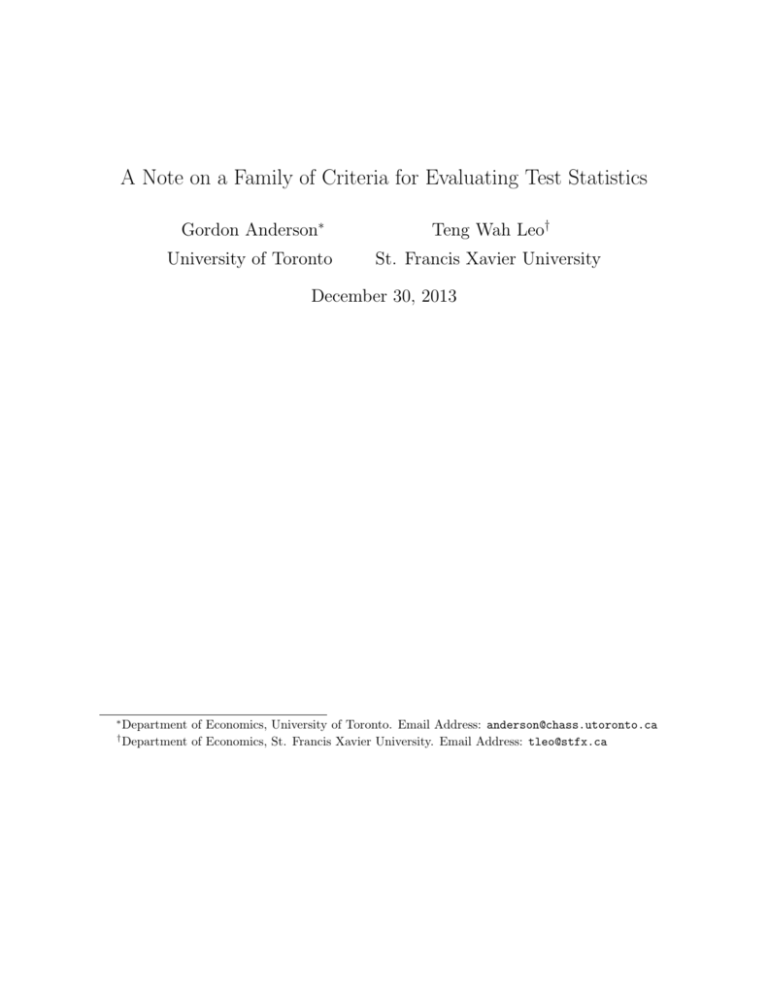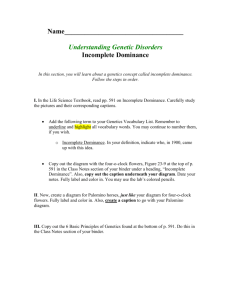A Note on a Family of Criteria for Evaluating Test Statistics
advertisement

A Note on a Family of Criteria for Evaluating Test Statistics
Gordon Anderson∗
Teng Wah Leo†
University of Toronto
St. Francis Xavier University
December 30, 2013
∗
†
Department of Economics, University of Toronto. Email Address: anderson@chass.utoronto.ca
Department of Economics, St. Francis Xavier University. Email Address: tleo@stfx.ca
Abstract
In noting that the usual criteria for choosing an optimal test, Uniform Power and
Local Power are at opposite ends of a spectrum of dominance criteria, a complete
“Power Dominance” family of criteria for classifying and choosing optimal tests on
the basis of their power characteristics is identified, wherein successive orders of
dominance attach increasing weight to power close to the null hypothesis. Indices
of the extent to which a preferred test has superior power characteristics over other
members in its class, and an index of the proximity of a test to the envelope function of alternative tests are also provided. The ideas are exemplified using various
optimal test statistics for Normal and Laplace population distributions.
1
Introduction
Choosing between alternative test instruments is usually based upon comparison of the
power properties of competing tests, and frequently it is a matter of visual comparison of
the respective power curves and the envelope of competing power curves (see for example
Conover et al. (1978), Juhl and Xiao (2003), Omelka (2005) and Ramsey (1971)). For
example, in considering a test1 H0 : µ ≤ µ0 versus H1 : µ > µ0 of size α, the choice
of test instrument Tk is usually based upon power considerations where, given β is the
probability of a Type 2 Error, i.e. β = Pr(Fail to reject H0 |H1 ), the power function
of the test is 1 − β(α, µ1 , Tk ), where µ1 ∈ H1 (see for example Lehmann and Romano
(2005)). For convenience in what follows, since we wish to consider the power function
as a cumulative density function, note that for consistent tests, the power function 1 −
β(α, µ1 , Tk ) ∈ [α, 1], so that letting F (µ1 |α, Tk ) =
f (µ1 |α, Tk ) =
dF (µ1 |α,Tk )
dµ1
1−α−β(α,µ1 ,Tk )
,
1−α
F (µ1 |α, Tk ) ∈ [0, 1], and
corresponds to a probability distribution of µ1 , for µ1 > µ0 .
Generally the test of choice, if it exists, is the Uniformly Most Powerful (UMP) test,
which for test statistics Tk , k = 1, 2, . . . , defines T1 as the UMP test if:
F (µ1 |α, T1 ) ≥ F (µ1 |α, Tk ) ∀ µ1 ∈ H1 and all k > 1
(with strict inequality holding somewhere). When no such test exists, resort is usually
made to the Locally Most Powerful (LMP) test criterion which defines T1 as the LMP
test if:
dF (µ1 |α, T1 )
dF (µ1 |α, Tk )
≥
∀ µ1 ∈ (µ0 , µ0 + δ] for δ small
dµ1
dµ1
These comparison criteria for statistical tests are very similar in nature and spirit
to the extremes of the family of stochastic dominance criteria used by economists in
empirical welfare and finance literatures. In essence, they are an expression, on the part
of the statistical investigator, of a preference for power, whereas Economists have used
them as an expression of preference for wellbeing or portfolio returns. What is interesting
here is that in the context of economic comparisons, the UMP and LMP criterion are
at opposite ends of the comparison spectrum in that literature, and as will be seen,
in between these ends are a plethora of comparisons which suit the particular needs of
1
A similar analysis is possible for two sided tests, but is omitted here for reasons of brevity.
1
the economic analysis, and so too it could be for statisticians when considering power
properties of tests.
2
Power Dominance & the Optimal Test
In economics literature, stochastic dominance is used as a criteria for choosing between
two potential distributions of a random variable x (usually income, consumption or a
portfolio return) in order to find the distribution which maximizes E(U (x)) based upon
the properties of the function U (.)2 , where U (.) represents a felicity function either of
agents in a society under the income size distribution of x (the incomes of its members)
or that derived from the size distribution of portfolio returns x. Working with U (x),
where for simplicity x is continuously defined over the range [a, b], and two alternative
states defined by pdf’s f (x) and g(x) describing the distribution of x across agents in
those states, the family of Stochastic Dominance techniques address the issue: “which
state is preferred if the objective is the largest E(U (x))?”. Formally, when U (x) is such
that (−1)i+1 ∂U∂x(x)
> 0, for i = {1, . . . , J}, a sufficient condition for:
i
Zb
Ef (U (X)) − Eg (U (X)) =
U (x)(dF − dG) ≥ 0
a
is given by3 :
FJ (x) ≤ GJ (x) ∀ x ∈ [a, b]
and FJ (x) < GJ (x) for some x ∈ [a, b]
Zx
where Fi (x) =
Fi−1 (z)dz
a
and F0 (x) = f (x)
An important notion regarding dominance relations is that dominance at order h implies
dominance at all orders h0 > h, and a useful lemma drawn from Davidson and Duclos
(2000) is that if F first order dominates G over some region (−∞, a), then F will dominate
G over the whole range of x at some higher order. The Wellbeing implication of various
2
3
Sometimes poorness indices P (x) are studied (Atkinson 1987) in which case U (x) = −P (x).
The intuition for how the result is arrived at follows in the discussion below.
2
dominance orders are4 :
U1 ∼ (requiring
dU (x)
dx
> 0) yields the first order dominance rule (referred to
as Utilitarian societal preferences), and is an expression of preference for more
of x, without regard to spread.
U2 ∼ (requiring
dU (x)
dx
> 0,
d2 U (x)
dx2
< 0) yields the second order dominance
rule (referred to as Daltonian societal preferences), and is an expression of
preference for more x, with weak preference for reduced spread.
U3 ∼ (requiring
dU (x)
dx
> 0,
d2 U (x)
dx2
< 0, and
d3 U (x)
dx3
> 0) yields a third order
dominance rule, and is an expression of preference for more x, with weak
preference for reduced spread, especially at the low end of the distribution.
..
.
U∞ ∼ or infinite order dominance, is referred to as Rawlsian societal preference
since it attaches infinite weight to the poorest individual, and can be examined
in the context of the relative incomes of the poorest individuals in 2 equally
populated societies5 .
In the Wellbeing and Finance fields, the stochastically dominating distribution is the
preferred distribution, reflecting as it does the desire for greater average U (x). In the
present “Power” context, the stochastically dominated (power dominant) distribution will
be the preferred distribution, reflecting as it does faster accumulating “correct” rejection
probabilities over alternative tests as µ1 increases. In other words, the question is “which
power function is preferred if the objective is smallest E(U (x)) or the fastest accumulation
of mass as µ1 moves away from H0 ?”. In this context, the UMP test criterion can be seen
to be closely associated with the first order stochastic dominance criterion, since it is first
order stochastically dominated by (or power dominate) the power functions of all other
tests (that is F (µ1 |α, T1 ) is first order stochastically dominated by all other F (µ1 |α, Tk ),
for k > 1). Intuitively, we seek the test which accumulates power most rapidly with
increasing µ1 . In a similar fashion, the LMP test criterion can be seen to be very similar
to the infinite order stochastic dominance criterion, since the test whose power function
4
The comparison procedures have been empirically implemented in several ways, see for example
Anderson (1996, 2004), Barrett and Donald (2003), Davidson and Duclos (2000), Linton et al. (2005),
Knight and Satchell (2008), and McFadden (1989).
5
Knight and Satchell (2008) have empirically implemented this order of dominance comparison.
3
is infinite order stochastically dominated by (or power dominate) the power functions of
all other tests is the LMP test (i.e.
dF (µ1 |α,T1 )
dµ1
≥
dF (µ1 |α,Tk )
µ1
for all µ1 ∈ (µ0 , µ0 + δ] for δ
small)6 . Second order power dominance comparisons can best be understood by considering the pdf’s of two power functions, that for expositional convenience are symmetric with
equal means, but different spreads. The first order power dominance comparison (UMP
comparison) would yield no conclusion because the cdf’s would cross at the mean (see for
example comparisons in Anderson (2001)). The second order power dominance comparison however would yield a decision favoring the distribution with the largest variance,
since the integral of its cdf would lay everywhere above that of the distribution with the
smaller variance. In a similar fashion, the third order power dominance comparison can be
best understood by considering two distributions with equal mean and variance, that are
left (positively) skewed, so that the third order power dominance relationship will favour
the one that is most left skewed. Essentially successive orders of “power dominance” can
be seen to attach increasing weight to mass close to the null hypothesis. Intuitively, power
function crossovers closer to the null require successively higher orders of integration to
satisfy a power dominance criterion, so that power dominance at order “i” represents a
stronger form of power dominance than that at order “i + k”, for k > 0.
Thus we are led to consider a family of Power Dominance criteria of the form:
Zµ1
(Fj (z|α, T1 ) − Fj (z|α, Tk )) dz
≥
0 , ∀ µ1 > µ0 and k 6= 1
µ0
Zµ1
where Fj+1 (µ1 |α, T )dz =
Fj (z|α, T )dz , and
F0 = f
µ0
as a j’th order power dominance criterion.
Furthermore, note that
Z∞
(Fj (µ1 |α, T1 ) − Fj (µ1 |α, Tk )) dµ1
P Bj+1 =
µ0
provides a measure of the power benefit of test 1 over test k at the j’th order comparison,
in other words it is a measure of how much better T1 is than Tk at order j. In this context,
6
It follows from the Davidson and Duclos (2000) lemma that if Test 1 first order power dominates
locally, as the (LMP) does, it will dominate at some higher order over the whole range of µ1 .
4
where the metric of the unstandardized measure is related to the units of (µ0 )j , P Bj+1
could be divided by a value of (µ0 )j , thereby making it a unit free measure.
Finally the Envelope of alternative power functions is frequently used for comparison
purposes (see Omelka (2005), and Juhl and Xiao (2003) for example), and proximity to it
gauged by visual inspection. The proximity could be quantified by a modification of P B
to the following form:
Z∞
K
(F (µ1 |α, Tk )) dµ1 , j ∈ {1, . . . , K}
F (µ1 |α, Tj ) − EN Vk=1
P BEj = −
µ0
K
= supK
where EN Vk=1
k=1 F (z|α, Tk ), and P BEj is a measure of the aggregate distance of
the power curve of the j’th test statistic from the envelope. Note the envelope will always
first order power dominate any of the individual tests from which it is constructed. P BEj
is thus a measure of the first order power dominance of the envelope over the j’th test,
and its proximity to 0 is a measure of how superior in power terms the j’th test statistic
is.
3
Examples
3.1
Example 1
The following illustrative example is for a sample mean (∼ N (µ, σ 2 /n)) and sample median
(∼ N (µ, πσ 2 /2n)) comparison using the above criteria for test size α.
The power function for a sample mean test is given by:
F (z|α, X) = 1 − Z
µ0 − µ1
√σ
n
!
+ Z1−α
The power function for sample median test is given by:
F (z|α, Xmedian ) = 1 − Z
µ0 − µ1
pπ
+ Z1−α
σ
2n
!
Note that consistent with the mean test being the uniformly most powerful test,
F (z|α, X) ≥ F (z|α, Xmedian ) , ∀ µ1 > µ0 and σ > 0
since,
µ0 − µ1
µ0 − µ1
pπ
>
∀ µ1 > µ0
√σ
σ
n
2n
5
and σ > 0
Hence the test using the mean is the first order dominated test, which is equivalent to a
test from the UMP class. The index of relative power would be:
!
!#
Z∞ "
µ0 − µ1
µ0 − µ1
1
Z pπ
+ Z1−α − Z
+ Z1−α
dµ1
P B1 =
√σ
µ0
σ
n
2n
µ0
which is positive for all finite σ > 0, and diminishing in σ.
3.2
Example 2
A second, perhaps more illuminating example is taken from Omelka (2005), and relates
to the power comparisons of the Locally Most Powerful Test (the sign test), the Wald
Test (the sample median), and the Maximum Likelihood Test for the location parameter
when data follow a Laplace (Double Exponential) distribution. Omelka (2005) is followed
in considering a random sample of size n = 10 drawn from a population described by the
pdf:
1 −|x−θ|
e
2
f (x) =
The test being considered is H0 : θ ≤ 0 against H1 : θ > 0, and the nominal size is
0.0546875. The 3 tests under consideration for this case are defined as:
n
P
1. Locally Most Powerful (Sign Test Statistic):
I(Xi > 0) ≥ K (c.v. K = 8
i=1
(Lehmann (1975)))
2. Wald (Median Test Statistic): Xmedian ≥ Cα (Cα = 0.625)
3. Maximum Likelihood: Xmedian ≥ 0 and 2
n
P
(|Xi | − |Xi − Xmedian |) ≥ Cα (Cα =
i=1
2.86)
Monte Carlo simulations (50,000 replications in each of 1,000 samples taken at 0.005
increments of θ from 0 to 4.995) facilitate generation of the power curves of the three test
statistics which are presented in figure 1.
Figure 2 illustrates the various orders of integration7 of the difference in the respective
power curves (Power(Sign Test) - Power(Wald Test)), and shows the power dominance of
the sign test at the fifth order of dominance, since it is the fifth curve that is everywhere
non-negative. The index of fifth order power dominance of the LMP statistic is 0.135.
7
Integration was approximated using the trapezoidal rule, which for small increments of θ (0.005),
provides a more than adequate approximation.
6
Figure 3 illustrates various orders of integration of the difference in the respective
power curves (Power(Likelihood Ratio Test) - Power(Wald Test)), and shows the power
dominance of the Likelihood Ratio Test at the second order. The index of second order
power dominance for this comparison is 0.077.
As for the P BE index of proximity to the envelope, the values for the LMP, Wald and
ML statistics are correspondingly 0.6398, 0.0821 and 0.0049, confirming the price of the
LMP test in overall power for values of θ further away from the null, and the advantages
7
of the ML statistic in overall power across the range of values of θ as inferred by visual
inspection in Omelka (2005).
References
Anderson, G. J. (1996). Nonparametric Tests for Stochastic Dominance in Income Distributions. Econometrica, 64, 1183–1193.
Anderson, G. J. (2001). The Power and Size of Nonparametric Tests for Common Distributional Characteristics. Econometric Reviews, 20, 1–30.
Anderson, G. J. (2004). Toward an Empirical Analysis of Polarization. Journal of Econometrics, 122, 1–26.
Atkinson, A. (1987). On the Measurement of Poverty. Econometrica, 55, 749–764.
Barrett, G. F. and Donald, S. G. (2003). Consistent Tests for Stochastic Dominance.
Econometrica, 71, 71–104.
Conover, W. J., Wehmanen, O., and Ramsey, F. L. (1978). A Note on the Small-Sample
Power Functions for Nonparametric Tests of Location in the Double Exponential Family. Journal of the American Statistical Association, 73, 188–190.
8
Davidson, R. and Duclos, J.-Y. (2000). Statistical Inference for Stochastic Dominance
and for the Measurement of Poverty and Inequality. Econometrica, 68, 1435–1464.
Juhl, T. and Xiao, Z. (2003). Power Functions and Envelopes for Unit Root Tests.
Econometric Theory, 2, 240–253.
Knight, J. and Satchell, S. (2008). Testing for Infinite Order Stochastic Dominance with
Applications to Finance, Risk and Income Inequality. Journal of Economics and Finance, 32, 35–46.
Lehmann, E. L. (1975). Nonparametrics: Statistical Methods Based on Ranks. San Francisco: Holden-Day.
Lehmann, E. L. and Romano, J. P. (2005). Testing Statistical Hypotheses. 3 edn. Springer.
Linton, O., Maasoumi, E., and Whang, Y.-J. (2005). Consistent Testing for Stochastic
Dominance under General Sampling Schemes. Review of Economic Studies, 72, 735–
765.
McFadden, D. (1989). Testing for Stochastic Dominance. In T. B. Fomby and T. K. Seo
(Eds.), Studies in the Economics of Uncertainty. New York: Springer-Verlag.
Omelka, M. (2005). The Behaviour Of Locally Most Powerful Tests. Kybernetica, 41,
699–712.
Ramsey, F. L. (1971). Small Sample Power Functions for Non-Parametric Tests of Location in the Double Exponential Family. Journal of the American Statistical Association,
66, 149–151.
9







